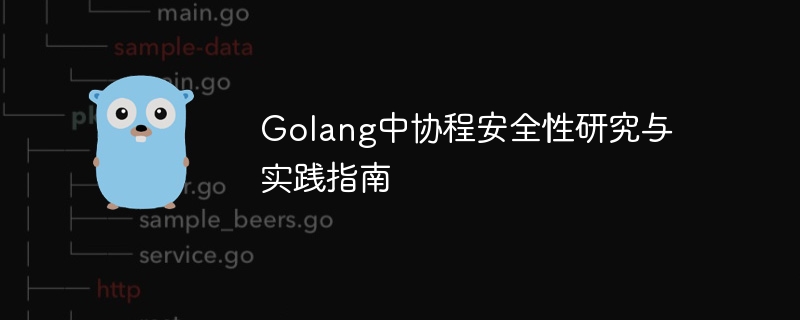Home >Backend Development >Golang >Research and practice guide on coroutine security in Golang
Research and practice guide on coroutine security in Golang
- WBOYWBOYWBOYWBOYWBOYWBOYWBOYWBOYWBOYWBOYWBOYWBOYWBOriginal
- 2024-03-11 11:12:03543browse

[Research and Practice Guide to Coroutine Security in Golang]
In the field of programming, coroutines are a lightweight concurrency processing mechanism that can effectively Improve program performance and simplify code logic. In the Golang language, goroutine, as the core feature of concurrent programming, is widely used in various fields, but it may also bring about some security issues. This article will focus on the security issues of coroutines in Golang and provide some practical solutions and best practices.
1. Background of coroutine security issues
In multi-thread programming, synchronization and access of shared data is often a key issue. When multiple coroutines concurrently access shared data, problems such as race conditions (Race Condition) or data race (Data Race) may occur, leading to uncertain behavior of the program, data corruption or even crash. In Golang, due to the characteristics of coroutines, these problems may become more complex and hidden.
2. Case analysis of coroutine security issues
For example, suppose there is a global variable count used to record the amount of a certain data, and multiple coroutines concurrently read count. fetch and update operations. Without proper synchronization, counting errors or data loss may occur.
package main
import (
"fmt"
"sync"
)
var count int
var wg sync.WaitGroup
func increment() {
defer wg.Done()
count++
}
func main() {
for i := 0; i < 1000; i++ {
wg.Add(1)
go increment()
}
wg.Wait()
fmt.Println("Final count:", count)
}In the above example, 1000 coroutines concurrently perform auto-increment operations on the count. However, due to the lack of synchronization mechanism, the final counting result may be affected by race conditions and the correct result cannot be obtained.
3. Solution to coroutine security
1. Use mutex lock (Mutex)
Mutex lock is one of the most commonly used concurrent synchronization mechanisms. It is guaranteed that only one coroutine can access shared resources at any time. For the above example, you can use a mutex to protect count access:
var mu sync.Mutex
func increment() {
defer wg.Done()
mu.Lock()
count++
mu.Unlock()
}2. Using Channel
Channel is used in Golang to achieve communication and synchronization between coroutines. An important mechanism that can replace mutex locks in some scenarios. Modify the above example as follows:
var ch = make(chan int, 1)
func increment() {
defer wg.Done()
ch <- 1
count++
<-ch
}4. Best practices and summary
In Golang, it is very important to correctly handle the security issues of coroutines. When writing concurrent code, you should always pay attention to access to shared resources and adopt appropriate synchronization mechanisms to ensure the security of data access. Common synchronization mechanisms include mutex locks, channels, atomic operations, etc. Choose the appropriate solution according to the specific scenario.
Through the introduction and examples of this article, I hope readers can better understand the importance of coroutine security and related solutions in Golang, rationally design concurrent programs, avoid security problems, and improve program stability. performance and reliability.
Conclusion
Coroutine security is an important topic in Golang concurrent programming, which requires developers to continuously accumulate experience and skills in practice. I hope this article will be helpful to readers and trigger a more in-depth discussion and thinking about the security of Golang coroutines.
The above is the detailed content of Research and practice guide on coroutine security in Golang. For more information, please follow other related articles on the PHP Chinese website!
Related articles
See more- What is php coroutine
- Coroutine database query using Swoole in Laravel 5.6
- What is the difference between coroutines and threads in go language
- How PHP applications use Memcache caching technology to improve data access speed
- Comparison of database replication and synchronization mechanisms between MySQL and TiDB

